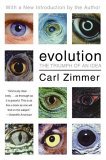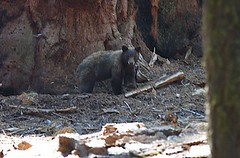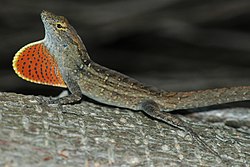Submitted by Pedro Garcia for Evolution
![]() Birds, birds, and more birds, with over 10,000 species of birds well known and classified, one can get an array of different colors which would make even the most non-bird lover’s staring in awe. With some species having such intricate combinations of reds, yellows, greens, and blues, (such as the scarlet macaw of South America) one might ask, “Why do they have such vibrant and magnificent plumage?” (or something along those lines). It’s a well known fact that skin and feather color (yellows and reds) is linked with carotenoids in the body. One well known example is the Caribbean flamingo, known for its brightly reddish/pink color. This species of bird gets its color from the high intake of beta-carotenes obtained from its diet of crustaceans and algae. But why? What good is it to be so brightly colored? One might even think that such bright colors would be a sort of bull’s eye for predators as if saying “Hey, you…the one with the sharp teeth…I’m over here!” Well, in short, it can all be explained by loosely quoting the hip hop song… “it’s all about sex, baby!”
Birds, birds, and more birds, with over 10,000 species of birds well known and classified, one can get an array of different colors which would make even the most non-bird lover’s staring in awe. With some species having such intricate combinations of reds, yellows, greens, and blues, (such as the scarlet macaw of South America) one might ask, “Why do they have such vibrant and magnificent plumage?” (or something along those lines). It’s a well known fact that skin and feather color (yellows and reds) is linked with carotenoids in the body. One well known example is the Caribbean flamingo, known for its brightly reddish/pink color. This species of bird gets its color from the high intake of beta-carotenes obtained from its diet of crustaceans and algae. But why? What good is it to be so brightly colored? One might even think that such bright colors would be a sort of bull’s eye for predators as if saying “Hey, you…the one with the sharp teeth…I’m over here!” Well, in short, it can all be explained by loosely quoting the hip hop song… “it’s all about sex, baby!”
That’s right, ongoing research has been linking brightly colored plumage in birds to…well, sex! This is the not-so-PG stuff that Darwin didn’t really talk about in his book (at least not directly), however it is merely the process of evolution at work. Researchers Negro, et al, (2002), have gone even more in depth concerning the correlation of plasma carotenoid-dependent skin color in relation to sexual selection. Their work consisted of analysis of brightness of color, not in the feathers, but, in the cere, lores, and tarsi of the small falcon the American Kestrel (Falco sparverius) along the time scale of mating season to hatching of offspring. As stated in the article, research has shown that color of plumage in birds does have an effect on sexual selection in brightly colored birds (Negro, 2002). As stated earlier, the brightness of plumage (specifically reds and yellows) is dependent on the amount of carotenoids found in the body; and beta-carotene is taken in directly from food source. Simply put, female birds choose the male with the brightest plumage because he is the one that can successfully obtain the most food, thus passing on the “better” genes to the offspring. As said before, it’s the process of natural selection at work.
Although there has been much research on sexual selection and plumage color, this article delves in even further and tries to find a correlation with skin color in birds as a function of sexual selection. It seems that, as hypothesized before, there is a brighter skin hue during the mating season. However, what came next seemed to be of even greater interest. It seems that, at least among American Kestrels, the “brightness” of the skin color began to fade as soon as the mating season ended. This was directly linked with a reduction in plasma-carotenoid levels (Negro, 2002). It is believed that the reduction occurs as a trade-off between sexual selection (during mating season) and maintaining better health (post-mating season). Since the bright coloration is no longer needed after mating, it would seem that a reduction in plasma-carotenoids would allow for the carotenoids to assist in other health-related body functions (such as anti-oxidants aiding in the reduction of oxidative damage by free radicals).
One concern I have with research is the methodology used for the experiments. All subjects were captive Kestrels from the “Avian Science and Conservation Center of McGill University, Canada…” which were fed a consistent diet of “…day-old cockerels” which were carotenoid-rich (Negro, 2002). This brings up my concern that the Kestrels were not mimicking natural processes, thus adding, in my eyes, a great amount of tolerance and bias to the results. It should be noted that the author does state that they have “previously shown that variation in plasma carotenoids during the mating period (April) was not attributable to diet, parasites or androgen levels” (Negro, 2002). Ideal settings that would eliminate this tolerance would include plasma collection of marked Kestrels in the wild throughout a series of mating and fledging seasons.
References
J. J. Negro, G. R. Bortolotti, J. L. Tella, K. J. Fernie, D. M. Bird (1998). Regulation of integumentary colour and plasma carotenoids in American Kestrels consistent with sexual selection theory Functional Ecology, 12 (2), 307-312 DOI: 10.1046/j.1365-2435.1998.00176.x
















 The study conducted by Smith took place in the Cascade Mountains of southwestern British Columbia, which is significant, because the Cascade Mountains create a rain shadow with the forests to the east being very dry and prone to burning. In this area, lodgepole pines are ubiquitous and their cones are serotinous, they remain closed for years after maturation to enable them to reseed areas after frequent burns (Smith, 1970). Douglas-firs are also common in this area and will alternate between years of crop failures and years of crop masts; large production. The squirrel population in this area is very stable, they first feed on Douglas-firs but switch to lodgepole pines during crop failures (Smith, 1970). The lodgepole pines serve as a nearly constant food source. On the west side of the Cascade Mountains, the situation is quite reversed. Lodgepole pines are rare, are nonserotinous, and may have cone crop failures (Mowat 1960). This results in a fluctuating squirrel population exerting less selection pressure on lodgepole pines, as they do not exploit as much of the cones. The squirrels in the east exert a selection pressure for harder lodgepole pine cones, and less seeds per cone in the Douglas-firs. Thus, the lodgepole pines exert a selection pressure for squirrels with stronger jaws, those that can eat the stronger cones (Smith, 1970). This change in squirrels is evident as the squirrels in the east have stronger jaw muscles than those in the west.
The study conducted by Smith took place in the Cascade Mountains of southwestern British Columbia, which is significant, because the Cascade Mountains create a rain shadow with the forests to the east being very dry and prone to burning. In this area, lodgepole pines are ubiquitous and their cones are serotinous, they remain closed for years after maturation to enable them to reseed areas after frequent burns (Smith, 1970). Douglas-firs are also common in this area and will alternate between years of crop failures and years of crop masts; large production. The squirrel population in this area is very stable, they first feed on Douglas-firs but switch to lodgepole pines during crop failures (Smith, 1970). The lodgepole pines serve as a nearly constant food source. On the west side of the Cascade Mountains, the situation is quite reversed. Lodgepole pines are rare, are nonserotinous, and may have cone crop failures (Mowat 1960). This results in a fluctuating squirrel population exerting less selection pressure on lodgepole pines, as they do not exploit as much of the cones. The squirrels in the east exert a selection pressure for harder lodgepole pine cones, and less seeds per cone in the Douglas-firs. Thus, the lodgepole pines exert a selection pressure for squirrels with stronger jaws, those that can eat the stronger cones (Smith, 1970). This change in squirrels is evident as the squirrels in the east have stronger jaw muscles than those in the west. The city may be the ultimate expression of the human effort to control our environment: in evolutionary ecological terms, it represents a strategy to minimize the risks of starvation and predation by creating habitats which dampen natural variability in climate and food availability, and provide shelter from predators. Simultaneously, humans also generate a considerable surplus of food, making cities attractive habitats to many other wild species. Recent theoretical work by myself and colleagues shows that typical changes in spatio-temporal patterns of food availability (higher and more predictable) and predation regimes (may be lower) accompanying urbanization can alter competitive dynamics such that weak competitors survive better in urban than in more natural habitats. This has several implications for species that are able to invade the novel urban habitat: higher population densities, potentially reduced selection pressures, and in turn, greater vulnerability to sudden environmental changes. In this presentation, I explore consequences for the evolution of commensalism and the continued coexistence of other species with humans, using recent work on house sparrows (the ultimate commensal now at risk in urban habitats), corvids (suburban Scrub Jays), and south Asian primates (urban Macaques and Langurs). I will also present an overview of several projects currently ongoing in my laboratory focusing on different effects of urban environments on bird behavior, ecology, and diversity, and describe opportunities for students to get involved!
The city may be the ultimate expression of the human effort to control our environment: in evolutionary ecological terms, it represents a strategy to minimize the risks of starvation and predation by creating habitats which dampen natural variability in climate and food availability, and provide shelter from predators. Simultaneously, humans also generate a considerable surplus of food, making cities attractive habitats to many other wild species. Recent theoretical work by myself and colleagues shows that typical changes in spatio-temporal patterns of food availability (higher and more predictable) and predation regimes (may be lower) accompanying urbanization can alter competitive dynamics such that weak competitors survive better in urban than in more natural habitats. This has several implications for species that are able to invade the novel urban habitat: higher population densities, potentially reduced selection pressures, and in turn, greater vulnerability to sudden environmental changes. In this presentation, I explore consequences for the evolution of commensalism and the continued coexistence of other species with humans, using recent work on house sparrows (the ultimate commensal now at risk in urban habitats), corvids (suburban Scrub Jays), and south Asian primates (urban Macaques and Langurs). I will also present an overview of several projects currently ongoing in my laboratory focusing on different effects of urban environments on bird behavior, ecology, and diversity, and describe opportunities for students to get involved! About two months ago I was fortunate enough to attend
About two months ago I was fortunate enough to attend 


